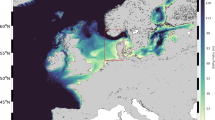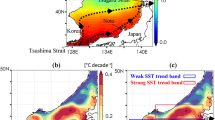Abstract
The sea wave energy has a significant potential to be converted in electrical one. However, there are still many difficulties to its harvesting. The most studied device is the Oscillating Water Column (OWC) wave energy converter, in which the majority of researches consider the air inside the chamber as a dry air. This study aims to investigate the influence of the environment humidity on the behavior and the performance of this device equipped with Wells and Impulse turbines. A numerical model, that uses the first law of thermodynamics to analyze a piston movement in a air chamber with a turbine, is developed to compare results of an ideal gas with those of a real gas. The behavior of the real gas inside the chamber is based on empirical parameters. An typical case of an onshore OWC in atmospheric conditions with high level of humidity of the south of the Brazilian cost is studied. Ranges of wave period and height and turbine characteristic relation for Wells and Impulse turbines are tested. Comparison between dry and real air gases inside the chamber for the same conditions of wave period, amplitude of the free surface oscillation inside the chamber and turbine characteristic relation for Wells and Impulse turbines are analyzed. Vapor precipitation is observed in cases where air pressure inside the chamber is higher than \(7.1\) kPa. In general, time-averaged pneumatic powers of real gases are slightly lower (\(2\%\) maximum) to those of ideal ones, which indicates that the influence of air humidity on the performance of the device is practically negligible. However, the definitive conclusion depends on the consideration of the coupling between hydrodynamics and aerodynamics in the process.









Similar content being viewed by others
References
Mork G, Barstow S, Kabuth A, Pontes TM (2010) Assessing the global wave energy potential. In: 29th International conference on ocean, offshore mechanics and artic engineering, Shangai, China, p. 8
Evans DV (1981) Power from water waves. Ann Rev Fluid Mech 13:157–187
Torres FR, Teixeira PRF, Didier E (2018) A methodology to determine the optimal size of a wells turbine in an oscillating water column device by using coupled hydro-aerodynamic models. Renew Energy 121:9–18
Gonçalves RAAC, Teixeira PRF, Didier E, Torres FR (2020) Numerical analysis of the influence of air compressibility effects on an oscillating water column wave energy converter chamber. Renew Energy 153:1183–1193
Evans DV (1982) Wave-power absorption by systems of oscillating surface pressure distributions. J Fluid Mech 114(1):481
Evans DV, Porter R (1995) Hydrodynamic characteristics of an oscillating water column device. Appl Ocean Res 17:155–163
Evans DV, Porter R (1997) Efficient calculation of hydrodynamic properties of OWC-type devices. J Offshore Mech Artic Eng 119(4):210–218
Perdigão J, Sarmento A (2003) Overall-efficiency otimisation in OWC devices. Appl Ocean Res 25:157–166
Falcão AFO, Henriques JCC (2014) Model-prototype similarity of oscillating-water-column wave energy converters. Int J Marine Energy 6:18–34
Sheng W, Alcorn R, Lewis A (2013) On thermodynamics in the primary power conversion of oscillating water column wave energy converters. J Renew Sustain Energy 5:023105
Josset C, Clément AH (2007) A time-domain numerical simulator for oscillating water column wave power plants. Renew Energy 32:1379–1402
Medina-López E, Ferrando AM, Gilabert MC, del Pino C, Rodríguez ML (2016) Note on a real gas model for OWC performance. Renew Energy 85:588–597
Medina-López E, Moñino A, Borthwick AGL, Clavero M (2017) Thermodynamics of an OWC containing real gas. Energy 135:709–717
Medina-López E, Borthwick AGL, Moñino A (2019) Analytical and numerical simulations of an oscillating water column with humidity in the air chamber. J Clean Prod 238:117898
Wallace JM, Hoobs PV (2006) Atmosferic science, an introductory survey, 2nd ed. Academic Press, Elsevier
Stull R (2011) Meteorology for scientists and engineers, University of British Columbia, 3rd Edition. Avaliable in open acess in: https://www.eoas.ubc.ca/books/Practical_Meteorology/mse3.html
Callen H (1985) Thermodynamics and an introduction to thermostatistics, 2nd edn. John Wiley, New York
Biel Gayé J (1998) Curso sobre el formalismo y los métodos de la termodinámica, Vol. 1, Ed. Reverte, Barcelona
Pitzer KS, Curl RF (1957) The volumetric and thermodynamics properties of fluids. III. Empirical equation for the second Virial Coefficient. Thermodyn Prop Fluids 79:2369–70
Tsonopoulos C (1974) An empirical correlations of second Virial coefficients. AIChE J 20(2):263–272
Tsonopoulos C, Heidman J (1990) From the Virial to the cubic equation of state. Fluid Phase Equilib 57:261–276
Prigogine I (1947) Etude thermodynamique des phénomènes irréversibles. Brussels Université, Thesis
Prigogine I (1968) Introduction to thermodynamics of irreversible processes, 3a edn. Wiley-Interscience, New York
Falcão AFO, Justino PAP (1999) OWC wave energy devices with air flow control. Ocean Eng 26:1275–1295
Falcão AFO, Henriques JCC (2019) The spring-like air compressibility effect in oscillating-water-column wave energy converters: Review and analyses. Renew Sustain Energy Rev 112:483–498
Sarmento AJNA, Gato LMC, Falcão AFO (1990) Turbine-controlled wave energy absorption by oscillating water column devices. Ocean Eng 17(5):481–497
Sheng W, Alcorn R, Lewis A (2014) Assessment of primary energy conversions of oscillating water columns. II. Power take-off and validations. J Renew Sustain Energy 6:053114
Weber JW, Thomas GP (2001) An investigation into the importance of the air chamber design of an oscillating water column wave energy device, In: Proceedings of the eleventh, international offshore and polar engineering conference stavanger, Norway
Münster A (1970) Classical thermodynamics. Wiley-Interscience, London
Borel L, Favrat D (2005) Thermodynamique et énergétique, Volume 1, de l’énergie à l’exergie, Presses Polytechniques et Universitaires Romandes - PPUR, Lausanne
Dean RG, Dalrymple RA (1984) Water wave mechanics for engineers and scientists, ced series on ocean engineering, Vol 2, Ed. World Scientific Publishing Co. Pte. Ltd, Singapore
Bohren CF, Albrecht BA (1998) Atmospheric thermodynamics. Oxford University Press, New York
Cruz J (2009) Ocean wave energy - current status and future prospectives. Springer Series in Green Energy and Technology, Bristol
Falcao AFO (2010) Wave energy utilization: a review of the technologies. Renew Sustain Energy Rev 14:899–918
Falnes J (2007) A review of wave-energy extraction. Mar Struct 20(0951):185–201
Sears FW, Salinger GL (1975) Thermodynamics, kinetic theory, and statistical thermodynamics, 3rd edn. Addison Wesley, Amsterdam
Simonetti I (2017) Optimization of oscillating water column wave energy converters - a numerical study, dissertation of Phd., University of Braunschweig and University of Florence
Torres FR, Teixeira PRF, Didier E (2016) Study of the turbine power output of an oscillating water column device by using a hydrodynamic-aerodynamic coupled model. Ocean Eng 125:147–154
Zemansky MW, Van Ness HC (1966) Basic engineering thermodynamics. McGraw-Hill, New York
Acknowledgements
J.D.G. is grateful to CAPES for supporting your postdoctoral research at Universidade Federal do Rio Grande.
Author information
Authors and Affiliations
Corresponding author
Ethics declarations
Conflict of interest
The authors declare that they have no conflict of interest.
Additional information
Technical Editor: Monica Carvalho.
Publisher's Note
Springer Nature remains neutral with regard to jurisdictional claims in published maps and institutional affiliations.
Appendices
Appendix A: Absolute humidity in inhalation (\(Q_t>0\))
Suppose that at instant t there is a volume \(V_1\) of the air inside the chamber, whose mass is \(m_1=m_{v1}+m_{d1}\), where \(m_{v1}\) and \(m_{d1}\) are vapor and dry air masses. When the inhalation process takes place, there is an input of mass \(\Delta m_0 = \Delta m_{v0} + \Delta m_{d0}\) (vapor and dry air mass increments) entering the chamber, from the atmosphere, between instants t and \(t + \Delta t\), see (Fig. 1). Therefore, the absolute humidity r at instant \(t+\Delta t\) during the inhalation process is given by
On the other hand, the absolute humidity at t is
whereas atmospheric absolute humidity can be calculated by
Thus, Eqs. (35) and (36) are used to re-write Eq. (34) as follows
The mass of the air inside the chamber at instant t (\(m_1\)) and the increment of atmospheric air (\(\Delta m\)) are given by
where \(\rho _1\) and \(\rho _0\) are specific masses of the air inside the chamber at instant t and of the atmosphere, respectively, and \(Q_t\) is the turbine flow rate between instants t and \(t+\Delta t\). Eqs. (38) can be re-written as follows
Substituting Eqs. (39) into Eq. (37), the absolute humidity inside the chamber (r) during the inhalation process can be determined at instant \(t+\Delta t\), based on the previous one (\(r_1\)).
Appendix B: Calculation of derivatives of Z, B, \(f_0\) and \(f_2\)
In this appendix, general expressions of derivatives of the compressibility factor (Z), the second coefficient of Virial (B) and temperature correlation functions (\(f_0\) e \(f_2\)) are deduced. These variables are included in the dynamic pressure equation for real gases, Eq. (27).
The first derivative of B with respect to temperature is given by
where
calculated from Eqs. (11).
The second derivative of B with respect to temperature is
with
where \(\chi _{\text {mol}}^{\prime }\) and \(\chi _{mol}^{\prime \prime }\) are deduced in "Appendix C". The second mixed derivative of B, with respect time and temperature, is given by
The time derivate of \(f_2\) is obtained by using Eqs. (11), that is
as well as the mixed derivatives of \(f_0\) e \(f_2\) are
Finally, the time derivate of Z is given by
Appendix C: The calculation of derivatives of \(\chi _{\text {mol}}\)
The derivate of \(\chi _{\text {mol}}\) with the temperature results in
The time derivate of \(\chi _{\text {mol}}\) is given by
The second mixed derivative of \(\chi _{\text {mol}}\), with respect time and temperature, is given by
where derivates of \(e_s\) (\(\dot{e}_s\), \(e_s^{\prime }\), and \(\dot{e}_s^{\prime }\)) are deduced in “Appendix D”.
Finally, the second derivative of \(\chi _{\text {mol}}\), with respect to temperature, is
Appendix D: The calculation of the derivatives of \(e_s\)
Equations (50) and (51) in “Appendix C” contain derivatives of \(e_s\), which can be calculated based on Eq. (3). Therefore, derivatives with temperature, time and mixed (time and temperature) are given by
Appendix E: Data of study cases
Rights and permissions
About this article
Cite this article
Gonçalves, J.D., de Freitas Teixeira, P.R. The effect of the environment humidity on the performance of an oscillating water column wave energy converter. J Braz. Soc. Mech. Sci. Eng. 44, 46 (2022). https://doi.org/10.1007/s40430-021-03348-z
Received:
Accepted:
Published:
DOI: https://doi.org/10.1007/s40430-021-03348-z




